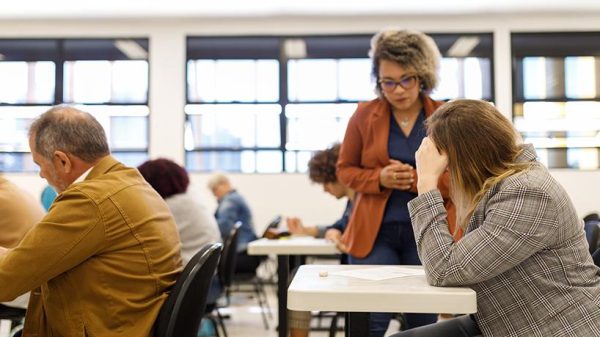On September 8, Learning Forward co-hosted a conversation on Twitter with Kathy Perret, instructional coach, trainer, and co-founder of #educoach, about how to leverage SEL so everyone can thrive this school year. The conversation was based on the August issue of The Learning Professional, which focused on the theme “Starting Strong” and included articles about building knowledge about social and emotional learning strategies, fostering educators’ resilience, and cultivating the support that school communities need to thrive.
Did you miss @LearningForward & @KathyPerret's co-hosted #EduCoach Twitter chat about how to leverage #SEL so everyone can thrive this school year? Catch the recap now. Share on XIn case you missed the Twitter chat, below are the six questions that we asked participants:
- SEL is always an important foundation for teaching and learning, but especially this year, as Suzanne Bouffard described in her editor’s column. How has COVID changed your (or your school’s) understanding about SEL?
- To show how SEL can be integrated in many places and ways in a school, “At a Glance” included a graphic created by the Learning Policy Institute based on a case study of a California elementary school. What are some creative or underutilized places and ways your school is nurturing SEL?
- In “Coaching with SEL in mind,” coaches from Northeast Independent School District in San Antonio, Texas explained how they are helping teachers integrate SEL into math instruction. Where does SEL fit in your curriculum and how can you help integrate it?
- SEL is everyone’s SEL is everyone’s responsibility, but it can help to have some dedicated SEL staff. Panorama Education created a tool for The Learning Professional to help educators assess their staffing needs and SEL-focused positions and responsibilities to fill them. Who leads SEL efforts in your school or district and how can you collaborate with them?
- As many articles in The Learning Professional issue highlight, SEL is just as important for adults as it is for students. How are you nurturing your own and your colleagues’ SEL in this stressful year?
- In her Coaches Corner column, Sharron Helmke pointed out that it’s important for coaches (and all educators) to remind themselves how they are making a difference. What’s one way you will find validation this year?
The questions above led to shared insights, strategies, and tools around social and emotional learning. Below are some takeaways from the Twitter chat:
Undoubtedly, COVID has changed educators’ and schools’ understanding of social and emotional learning. While many schools already had SEL plans before COVID, educators report an increased awareness of SEL in schools; a shift in how educators view SEL; clearer SEL plans; prioritizing relationship building; a newfound focus on establishing an equity-centered SEL lens; increase in demand for incorporating SEL competencies and activities into classrooms; a greater emphasis on reflection and intentionality in staff meetings; and importance on shared responsibility and resilience. [See featured tweets below]
A1: It’s been powerful to hear Ts discuss the need & connect practices like welcoming activities/optimistic closures to content learning. At a PD a T said she used to think SEL was just fluffy stuff, but now knows SEL deepens learning thru reflection & communication. #educoach pic.twitter.com/eAcghOS79j
— Ashley Taplin (@AshleyPTaplin) September 9, 2021
A1: It made us all realize that #SEL is not an “extra” thing, but it is THE thing. #educoach
— Lisa Casas (@LisaCasas) September 9, 2021
Educators have been exceptionally creative in how they are nurturing SEL in their classrooms and schools. For instance, they are pairing SEL competencies with math standards in instruction activities, redesigning the classroom to have dedicated spaces for students who are feeling overwhelmed or upset, assigning students leadership roles like “mindful managers” who encourage and compliment their peers, reserving time at the beginning of all meetings to check-in with staff, incorporating SEL Lunch & Learns, providing meditation outside, and creating graduate profiles with characteristics of SEL competencies. [See featured tweets below]
A2. SEL fits in across the curriculum. It’s about addressing the heart before content. SEL fits all year long at any time especially when kids are struggling. #educoach #rethink_learning pic.twitter.com/fveGAynjwh
—
Barbara Bray (she/her)
live & learn on purpose (@bbray27) September 9, 2021
A2:The @LPI_Learning graphic pairs great w a term @CoachBekah_Lu & @NEISDLeads say- “explicit dialogue.” We made this
to show that naming the reason why we check-in (self-awareness) or why we work in groups (relationship skills) nurtures engagement & purpose of SEL. #educoach pic.twitter.com/h17sZWWUQ3
— Ashley Taplin (@AshleyPTaplin) September 9, 2021
There really are countless ways of integrating SEL into the curriculum. As one educator put it, “SEL lives everywhere!” To help educators integrate SEL into their curriculum, schools are creating SEL tools for educators, dedicating professional learning to SEL curriculum, analyzing curriculum to identify SEL opportunities, finding stronger connections between SEL and social studies curriculum, establishing SEL learning targets; encouraging teachers to use inclusive openings and optimistic closings in lessons, and giving students a voice/choice in lesson design. [See featured tweets below]
#EDUCoach Q3 We’ve found a strong connection between SEL and our social studies curriculum. Within the citizenship and history strands- helping kids connect with both their own feelings and emotions as well as developing empathy and understanding of others!
— Samantha Voris (@voris_samantha) September 9, 2021
A3: SEL Learning Targets! Then SEL can live in curriculum, instruction, and assessment! #buildanSELculture #practicesnotproducts #EduCoach pic.twitter.com/Oqfsj0LyWC
— Stevenson SEL (@mollygosline) September 9, 2021
As noted earlier, SEL is everyone’s responsibility, but it can help to have dedicated SEL staff. Educators from the chat report districts having: SEL liaison in each of their buildings; dedicated departments who oversee SEL activities; SEL instructional coaches; teams from a variety of roles leading SEL efforts; their instructional leaders leading SEL efforts; language arts programs leading SEL efforts; and IT specialists leading SEL professional development. [See featured tweets below]
A4. Not only is SEL a top strategic priority for many districts, but it’s also an emerging profession.
Over the past several months, many districts have been hiring for new #SEL positions in response to emerging student needs. https://t.co/m5qJnm0Lda #EduCoach #TheLearningPro pic.twitter.com/kjlOQ2Pwsu
— Panorama Education (@PanoramaEd) September 9, 2021
A4: We have SEL coaches who are in a separate department than academic content. However, when we realized the connectedness of our work with instr. coaching and sharing new instr. strategies, we began collaborating weekly to learn, grow, and share together. #educoach
— Ashley Taplin (@AshleyPTaplin) September 9, 2021
SEL is just as important for adults as it is for students. Educators are nurturing their own and their colleagues’ SEL by: providing space for self-care (e.g. journaling, reflection, exercising and meditation); finding opportunities to cultivate self-awareness through mindful practices; highlighting the value of SEL in conversations with colleagues; checking in with colleagues; deliberately forming safe spaces for colleagues to express themselves openly; setting boundaries; staying committed to one’s values; intentionally saying less and listening more; letting go of the things that cannot be controlled; building and maintaining close relationships within teams; taking more breaks throughout the workday; and getting an appropriate amount of sleep. [See featured tweets below]
A5: This blog by @JustinaSchlund of @CASELorg has some great examples of how schools supported #SEL for educators and school staff during the pandemic. #EduCoach https://t.co/SW9zSt9QRT
— Learning Policy Inst (@LPI_Learning) September 9, 2021
A5…for me…being more intentional in ‘saying less, and listening more’. Embracing silence…waiting for the stories to emerge…and bringing coffee and goodies to meetings on a more frequent basis…#educoach https://t.co/4gO9G32TxK
— Jim Thompson (@Schoolguy) September 9, 2021
It is important for coaches (and educators) to remind themselves how they are making a difference. Educators from the chat say they are finding validation: through conversations and collaboration with teachers; from students and teachers having access to the digital applications they need with little to no lag time; from the sense of clarity received after facilitating student groups; from the smiles and laughter heard in classrooms after co-modeling with a teacher; by asking formative check-out questions after a coaching session; and allowing time and space for celebrating successes and growth. [See featured tweet below]
A6: Ask those that I am coaching. I appreciate formative check-out questions such as “What was most helpful from our conversation and time together today?” I also find pausing to build clarity is helpful for validation-in both directions. #EduCoach
— Laura Hilger (@hilgerl) September 9, 2021
You can view the archived version of the full chat here. To be notified of future Twitter chats, follow us on Twitter @LearningForward. Thank you to all participants for contributing to this conversation.









